| Columns Retired Columns & Blogs |
May be KR could review the new McIntosh M-1254 Class-D, 4-channel amp ($4,500), with the new multi-channel set-up :-) .........
I began listening with stereo tracks and heard at once a sense of the same rightness that I had enjoyed with the DSP-based speakers I discussed above. Bass was clean and tight; midrange detail and transparency were excellent. From memory, overall balance was a smidgen less forward than with the F228Be, but I also noticed that when I compared them side-by-side at the Harman Store on Madison Avenue before placing my order. Compared to the recently departed B&Ws, set at comparable levels and with my ear to the tweeter, the Studio2 had much lower noise, and the character of the noise was more of a soft hiss than a hash. I take that as indicative of the smoother, flatter treble response that I hear when playing music. Thus the issues I've had with the rendering of Dame Emma Kirkby's voice in Mozart's glorious "Exsultate Jubilate" (CD, L'oiseau-Lyre 168055) do not exist with the Studios. She sounds as pure and even, although a bit more distant, using the Benchmark amps. I'll say no more about two-channel but refer you to my original Studio2 review for full details (and JA's measurements).
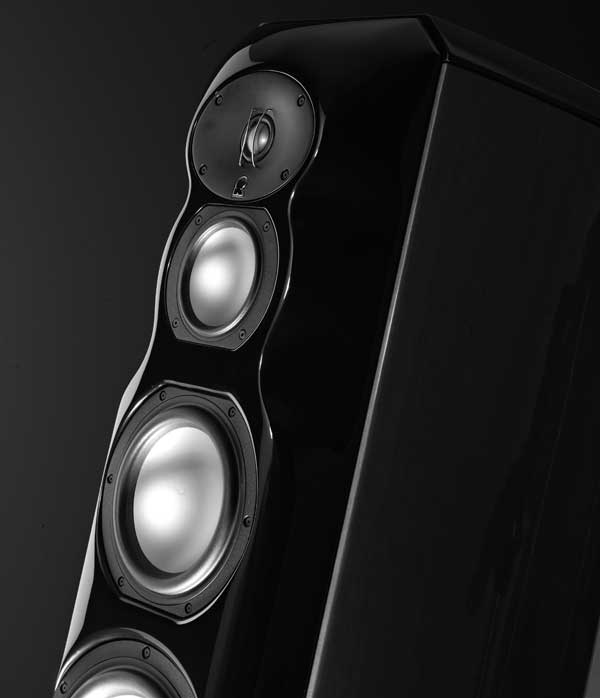
With that, I moved on to the main course: multichannel. To no surprise, the Revels were just super and offered the most coherent and integrated surround I can recall. Thus switching from a good stereo presentation to the surround version of Finzi's "Come Away, Come Away, Death," sung by Marianne Beate Kielland (SACD, 2L Records 2L-064-SACD), was not jarring but illuminating. Voice and piano remained in place while the soundstage widened and the lateral and rear boundaries of the space melted away. I dug out what I recalled as a recording with great dynamics and ambience, the National Brass Ensemble's Gabrieli: Selections from Sacrae Symphoniae (SACD, Oberlin Music OC15-04), only to be stunned by the clarity of each instrument in the brass panoply, the solidity and power of the organ and, overall, the enormous and undeniable presence of the space that I was sharing with the ensemble. I can say the same—with the addition of strings, winds, and singers—about the thrills and chills I get from Ludovic Morlot and the Seattle Symphony's spectacular recording of Berio's Sinfonia (24/96 5.1channel WAV download, Seattle SSM1018).
Absolutely every recording I've tried, including familiars from Sara K, Michael McDonald, Dire Straits, and Alison Krauss, was revealed with more transparency and acoustical context than I have enjoyed before. The lead voices are more distinctive and present while the accompaniment and ambience are more naturally relaxed. In a surprise, I discovered that the Hoff Ensemble's acoustic jazz album Polarity (SACD+BluRay Audio, 2L Records 2L-145-SABD), which I had found so impressive in 5.2.4 Auro-3D via the Trinnov Altitude A/V preamplifier in my Connecticut system, was much more satisfying in 5.1 via the Revels. Sure, the elimination of the height channels compromised the image of the drummer sitting behind the listener, but gee whiz: The piano and bass up front are as solidly real as they would be from the front table in a jazz club. And just to finish up where I began in multichannel, this setup places around me and delineates all the individual instruments in Willie Nelson's Night and Day (DVD-A, Surrounded By Entertainment SBE1001-9) as I sit, feeling at home, in their studio.
Regardless of the recording, the Revels were able to conjure a convincing spatial impression. Beyond that, the aural image seemed almost completely disassociated from the Studios and the F206s, spread from wall to wall, all around back and way forward to the middle of Third Avenue beyond my front wall. I cannot know what a trio or quintet of DSP speakers would sound like since I have only experienced them in stereo pairs, but I cannot yet imagine much beyond what I have now with the Revels in my room. As both Jim Austin and Larry Greenhill have recently reported about the Salon2, it is as relevant and fiercely competitive as when I first reviewed it—but this time I'm keeping them.
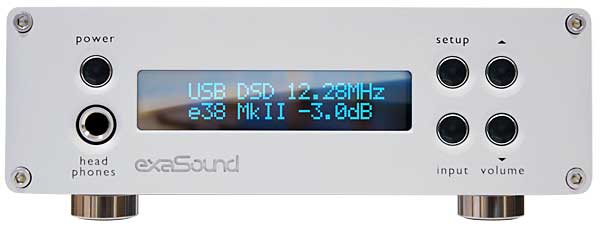
exaSound E38 Mark II DAC
I have been using exaSound multi-channel DACs for as long as they've been available (footnote 2). They are not inexpensive, but they remain the least expensive multichannel DACs that will support high resolutions and DSD. Later model Oppo disc players, when available, were an alternative, but they are no longer being manufactured and, frankly, I found them less than convenient in use. Today's more frugal alternatives, like the DSP U-DAC8, or multiple DACs of your choice connected to a miniDSP U-DIO8 interface, do not support DSD and limit PCM resolution to 24/192. Now, let's not be dismissive of those, or of using the HDMI input on a preamp/processor or AVR—but one can play and enjoy all that hi-rez can do in multichannel only by stepping up to one of the exaSound DACs (or other even more expensive options).
The exaSound e38 8-channel DAC has been the core of my system since early 2017 and, as with the earlier e28 and e28 Mark II, I have felt no need for improvement. That does not mean there is no room for improvement, as I learned with each succeeding product. In the past, model-to-model performance differences were subtle, all in the realms of increased midrange detail delineation and progressively lowered noise. Although I could run from the output of the e38 directly to my power amps using the balanced lines with good quality Kubala-Sosna or Cardas RCA-to-XLR adapters, I didn't because any improvements did not compensate for the convenience of my Audio Research MP-1 preamp for input switching and volume control.
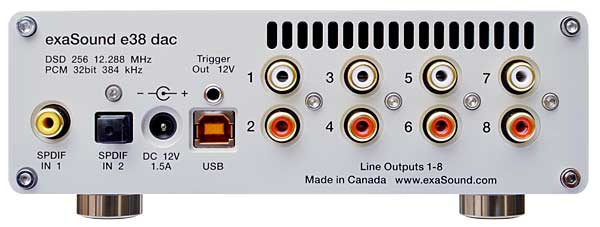
What's new in exaSound's e38 Mark II 8-channel DAC ($3999 with RCA outputs, $4300 for a limited-edition version with balanced mini-XLR outputs) is, primarily, the implementation of its Sabre ES9038PRO DAC chip, with four times as many internal paralleled DAC channels as the ES9028PRO in the original e38. There are also redesigned reference voltage sources and master clock power circuits as well as redesigned mainboard and output stages. The e38 Mark II I have is the version with balanced outputs, and exa's George Klissarov assures me that none of that version's specs differ, other than doubling the unbalanced version's output level, from 2.1V to 4.2V. Strangely, exaSound's noise specs for the Mark II are not better than those of the e38: The e38 is said to have a S/N ratio of 125dB and a total THD+noise of 0.00036%, while the Mark II's numbers are 123dB and 0.0004% (although the latter could be a matter of rounding numbers). That said, these numbers are all more than respectable.
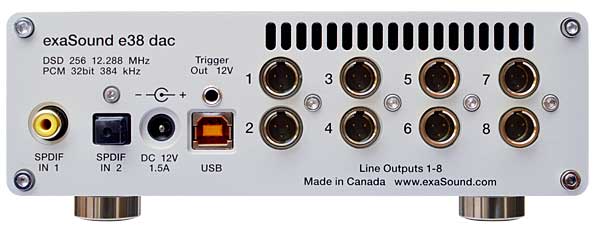
I bought a set of short, generic mini XLR-female-to-XLR male cables (footnote 3), to connect the e38 Mark II to my preamp. Side-by-side comparison of the RCA-output e38 with the XLR-output e38 Mark II, after gain matching, revealed that, through the window of my new amps and speakers, the midrange of the Mark II was somewhat more detailed and open compared to the original, and that the soundstage in its entirety was remarkably seamless. My conclusion is that the Mark II is, as we've seen before, a satisfying but not spectacular improvement over its predecessors and is worth keeping. But bear in mind, this is with the preamp in circuit that has a S/N ratio of only 95dB (despite its prodigious output capability of 12 volts!).
I took advantage of the Mark II's balanced output to connect directly to the dead-silent Benchmark amps and—surprise!—that made a big difference. Especially late in the evening and into the night, when the Manhattan traffic fades away (the night punctuated by the occasional passing semi), there seemed to be exquisite low-level detail at any reasonable volume setting, accompanied by dynamics of remarkable ease and range. I thought this the optimal way to hear what the e38 Mark II can do and eminently preferred it over using a preamp—although, even with the use of a handy Apple remote control, it is still a bit less convenient.
Each version of exaSound's multichannel DACs, now represented by the e38 Mark II, has set a standard for multichannel music playback. By today's standards, this one is pretty much beyond criticism.
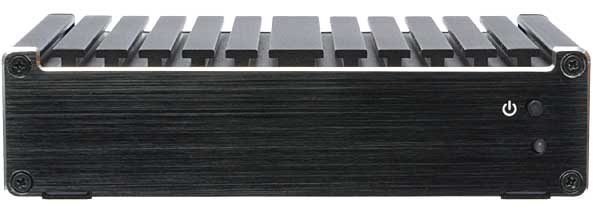
exaSound Sigma Streamer
A good deal of exaSound's "secret sauce" is in their proprietary ASIO/ALSA drivers for Win/Mac-based devices—but for various reasons, they have never offered the correspond ing driver for Linux-based streamers. (I wonder if this was a wise business decision, since it excludes an increasing array of players and streamers.) The company's PlayPoint series of network player/streamer/DACs have offered a solution, but these have been feature-rich and correspondingly pricey. Finally, with the release of their simple Sigma Streamer ($750), anyone who wants to stream music to an exaSound DAC, via wired or wireless LAN, has a relatively easy choice.
The Sigma is a Roon-ready end-point, can function as an HQPlayer network audio adapter, and is compatible with UPnP, OpenHome, and AirPlay protocols. It can handle any and all formats/resolutions supported by exaSound DACs, including native DSD up to DSD256, DXD, PCM up to 32/384, and, with supported DACs, full unfold of MQA. I used the Sigma Streamer with the original e38 in my Connecticut system and with the e38 Mark II in my New York system and confirmed most of these features, except MQA and AirPlay.
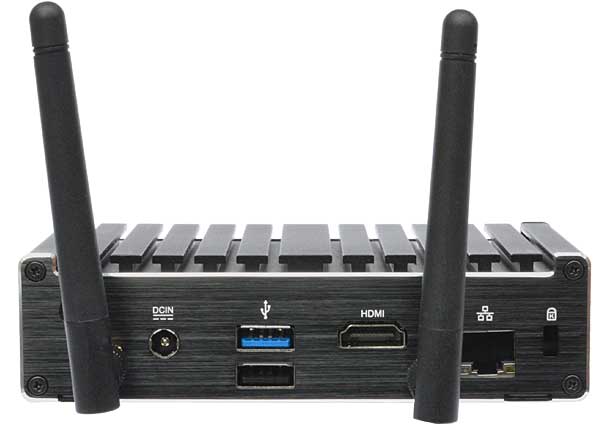
Installation in a wired LAN is a piece of cake. Connect the Sigma with an RJ45 cable to the LAN, connect it to the DAC via USB, and power them on. That's it. Roon recognizes the attached DAC and knows its features; select it as an output and play. With other players, such as JRiver, it appears as a network-attached output, which can be selected as a UPnP zone; assuming you're using one of exaSound's multichannel DACs—the company guarantees compatibility with only their own DACs, although they welcome owners of other DACs to try it out—you merely set the format for DLNA output to original format and you are done. Even easier with HQPlayer.
If you want to run it wirelessly, you first need to connect it wired to a LAN so that you can access the Sigma's webpage for configuration and control. Once opened, it lets you log in to your wireless LAN with an ID and password that the Sigma remembers. After that, it will be accessible by Wi-Fi both for streaming and for future access to the control webpage.
So that's it: Playing to the e38 via USB or via the Sigma Streamer was fine, the sounds of the two approaches identical—just as they should be. The Sigma Streamer is easy to use and completely functional as a network link for the exaSound DACs.
Footnote 3: These cables failed to survive more than a few weeks, their weak point being the design and construction of their miniXLR connectors; I have ordered new cables with what seems to be more robust miniXLR connectors. Since the e38 chassis is too small to accommodate full-size XLRs, exaSound should have employed the more robust DB25 connector, as used in the above-mentioned miniDSP U-DIO8.

May be KR could review the new McIntosh M-1254 Class-D, 4-channel amp ($4,500), with the new multi-channel set-up :-) .........

The MI254 does not look like something appealing to me. It has 4 channels while I can see uses for 3,5,7........ Looks like a CI device.

Their cost seem to be reasonable for their specified power output ........ You could consider two of those for a 7 channel set-up, including height channels (or, side channels) ...... Of course, in that 7 channel set-up one of the channels will not be used :-)

Certainly, it has its uses but I am sticking with 5.1 because there's no significant music repertoire in formats with more channels at this time.

Dear Kal, Just like you I am amazed by the sonic qualities of the Benchmark AHB2 (They drive my Magnepan MG20.7's in monoblock). May I ask which gain setting you to use? I was floored by the boost in performance when I set it to the lowest gain-setting. It does require a pre-amp processor be able to provide a sufficient voltage swing. My Emotiva XMC1 with 11Vrms voltage swing can drive it. The Gain switch is worthwhile to explore. Once you think you get this fantastic performance, it even gets better.

Yes, I have written about this option and how well it suits me to use the lowest gain setting with my Audio Research MP1 preamp. The MP1 has oodles of output (>14Vrms) but not so great SNR. OTOH, aside from the improved noise performance, I do not perceive any other sonic changes.

So far, I keep them on.

... Sescom, which use Switchcraft mini-XLR and Neutrik XLR connectors?

I did not buy them from Sescom but the ones I did buy had the Switchcraft mini-XLRs that failed. The specific fault was inadequate internal strain relief. It may not be entirely the fault of the Switchcraft connectors as much as the assembler's choice of cable.
Now using new cables with Rean mini-XLRs (and Neutrik XLRs), heftier cables and excellent strain relief.